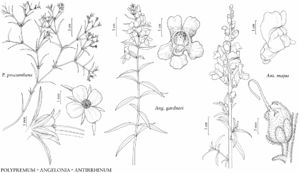Angelonia gardneri
Bot. Mag. 66: plate 3754. 1839.
Stems slightly 4-angled, 30–50 cm, stipitate-glandular, especially on angles. Leaves: blade narrowly lanceolate, 40–90 × 5–15 mm, smaller distally, base narrowed, apex acute, abaxial surface glandular-pubescent, adaxial glabrous, sometimes sparsely glandular-pubescent when young. Racemes glandular-pubescent; bracts 5–20 × 4–10 mm, larger in fruit, flowers 1 per axil. Pedicels strongly recurved in fruit, 9–12 mm, glandular-pubescent. Flowers: sepals 3–4 × 2–3 mm, margins pale; corolla-tube white to purple with darker spots within, 3–5 mm, throat 9–12 mm diam., palate concave, 3–5 mm; filaments 3–4 mm. Capsules globular, 3–8 mm, glabrous; style and stigma persistent. Seeds 1–1.5 mm, reticulate-alveolate. 2n = 20 (India).
Phenology: Flowering May–Oct.
Habitat: Roadsides, disturbed ground.
Elevation: 0–100 m.
Distribution
Introduced; Fla., South America (Brazil), also elsewhere in South America, Asia, Africa, Pacific Islands
Discussion
Mature fruits are seldom found in the flora area. Purple, pink, white, and variegated corolla forms of Angelonia gardneri and the Mexican A. angustifolia Bentham, distinguished by its glabrous stems and larger flowers, are grown as annuals in temperate North America, Europe, and Asia.
Angelonia gardneri has not been collected outside of cultivation since the 1940s; it has become much more common in cultivation and is very likely to escape.
Selected References
None.
